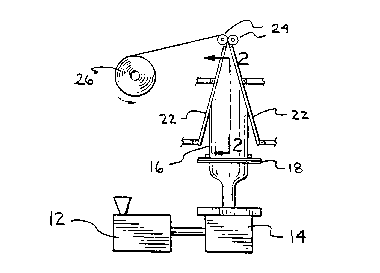Some of the information on this Web page has been provided by external sources. The Government of Canada is not responsible for the accuracy, reliability or currency of the information supplied by external sources. Users wishing to rely upon this information should consult directly with the source of the information. Content provided by external sources is not subject to official languages, privacy and accessibility requirements.
Any discrepancies in the text and image of the Claims and Abstract are due to differing posting times. Text of the Claims and Abstract are posted:
| (12) Patent: | (11) CA 2104552 |
|---|---|
| (54) English Title: | COLLAPSING FRAME FOR MOVING TUBES OF PLASTIC MATERIAL |
| (54) French Title: | CADRE A EFFONDREMENT POUR TUBES EN MOUVEMENT CONTENANT DES SUBSTANCES EN PLASTIQUE |
| Status: | Expired and beyond the Period of Reversal |
| (51) International Patent Classification (IPC): |
|
|---|---|
| (72) Inventors : |
|
| (73) Owners : |
|
| (71) Applicants : |
|
| (74) Agent: | GOWLING WLG (CANADA) LLP |
| (74) Associate agent: | |
| (45) Issued: | 2000-02-29 |
| (22) Filed Date: | 1993-08-20 |
| (41) Open to Public Inspection: | 1994-03-17 |
| Examination requested: | 1997-02-24 |
| Availability of licence: | N/A |
| Dedicated to the Public: | N/A |
| (25) Language of filing: | English |
| Patent Cooperation Treaty (PCT): | No |
|---|
| (30) Application Priority Data: | ||||||
|---|---|---|---|---|---|---|
|
A collapsing frame for collapsing a moving tube of
plastic material from a circular cross section to a
flattened form has a pair of frame members positionable on
diametrically opposite sides of the tube to converge towards
each other in the direction of movement of the tube so as to
collapse the tube by engagement of the tube therewith. Each
frame member has mounted thereon for engagement by the tube
a series of longitudinally spaced roller assemblies mounted
for free rotation about axes substantially transverse to the
direction of movement of the tube. Each roller assembly
comprises at least one rotatable roller having a peripheral
surface oriented to tend to move the tube at an outwardly
inclined angle to the direction of movement of the tube.
Note: Claims are shown in the official language in which they were submitted.
Note: Descriptions are shown in the official language in which they were submitted.

2024-08-01:As part of the Next Generation Patents (NGP) transition, the Canadian Patents Database (CPD) now contains a more detailed Event History, which replicates the Event Log of our new back-office solution.
Please note that "Inactive:" events refers to events no longer in use in our new back-office solution.
For a clearer understanding of the status of the application/patent presented on this page, the site Disclaimer , as well as the definitions for Patent , Event History , Maintenance Fee and Payment History should be consulted.
| Description | Date |
|---|---|
| Inactive: IPC expired | 2019-01-01 |
| Time Limit for Reversal Expired | 2009-08-20 |
| Letter Sent | 2008-08-20 |
| Inactive: IPC from MCD | 2006-03-11 |
| Inactive: IPC from MCD | 2006-03-11 |
| Grant by Issuance | 2000-02-29 |
| Inactive: Cover page published | 2000-02-28 |
| Inactive: Final fee received | 1999-11-30 |
| Pre-grant | 1999-11-30 |
| Notice of Allowance is Issued | 1999-06-10 |
| Letter Sent | 1999-06-10 |
| Notice of Allowance is Issued | 1999-06-10 |
| Inactive: Status info is complete as of Log entry date | 1999-06-08 |
| Inactive: Application prosecuted on TS as of Log entry date | 1999-06-08 |
| Inactive: Approved for allowance (AFA) | 1999-05-28 |
| All Requirements for Examination Determined Compliant | 1997-02-24 |
| Request for Examination Requirements Determined Compliant | 1997-02-24 |
| Application Published (Open to Public Inspection) | 1994-03-17 |
There is no abandonment history.
The last payment was received on 1999-07-21
Note : If the full payment has not been received on or before the date indicated, a further fee may be required which may be one of the following
Patent fees are adjusted on the 1st of January every year. The amounts above are the current amounts if received by December 31 of the current year.
Please refer to the CIPO
Patent Fees
web page to see all current fee amounts.
| Fee Type | Anniversary Year | Due Date | Paid Date |
|---|---|---|---|
| MF (application, 4th anniv.) - standard | 04 | 1997-08-20 | 1997-07-03 |
| MF (application, 5th anniv.) - standard | 05 | 1998-08-20 | 1998-06-26 |
| MF (application, 6th anniv.) - standard | 06 | 1999-08-20 | 1999-07-21 |
| Final fee - standard | 1999-11-30 | ||
| MF (patent, 7th anniv.) - standard | 2000-08-21 | 2000-07-18 | |
| MF (patent, 8th anniv.) - standard | 2001-08-20 | 2001-07-05 | |
| MF (patent, 9th anniv.) - standard | 2002-08-20 | 2002-06-06 | |
| MF (patent, 10th anniv.) - standard | 2003-08-20 | 2003-06-25 | |
| MF (patent, 11th anniv.) - standard | 2004-08-20 | 2004-07-27 | |
| MF (patent, 12th anniv.) - standard | 2005-08-22 | 2005-07-08 | |
| MF (patent, 13th anniv.) - standard | 2006-08-21 | 2006-08-17 | |
| MF (patent, 14th anniv.) - standard | 2007-08-20 | 2007-07-27 |
Note: Records showing the ownership history in alphabetical order.
| Current Owners on Record |
|---|
| MIREK PLANETA |
| Past Owners on Record |
|---|
| None |